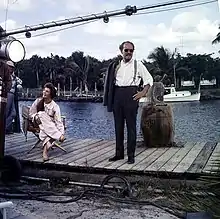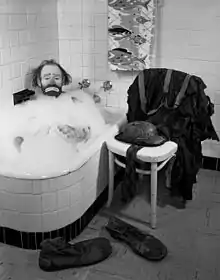Emmett Kelly
Emmett Leo Kelly (December 9, 1898 – March 28, 1979) was an American circus performer, who created the clown figure "Weary Willie", based on the hobos of the Great Depression in the 1930s. According to Charles W. Carey, Jr.:
- Kelly’s creation of Weary Willie revolutionized professional clowning and made him the country’s most familiar clown. The sad-sack, shuffling antics of his unkempt, downtrodden hobo offered a complete contrast to the madcap cavorting of brightly colored, white-faced conventional clowns and has served as an alternate model for professional clowns ever since.[1]
Emmett Kelly | |
|---|---|
.jpg.webp) Kelly ca. 1953 | |
| Born | Emmett Leo Kelly December 9, 1898 |
| Died | March 28, 1979 (aged 80) |
| Resting place | Rest Haven Memorial Park, Lafayette, Indiana |
| Other names | Weary Willie |
| Occupation | Circus clown |
| Spouse(s) | Eva Mae Moore
(m. after 1923)Elvira Gebhardt
(m. 1955; |
| Children | 4, including Emmett Leo Kelly Jr., Patrick, Stasia & Monika |
| Signature | |
 | |
Career
Emmett Kelly met his first wife, Eva, when working at the John Robinson Circus.[2]

Kelly appeared in the 1952 Oscar winner for Best Picture The Greatest Show on Earth. In 1956, he starred in a dramatic role, a TV adaptation of the story of Wilhelm Voigt, the "Captain From Kopenick," who masqueraded as a Prussian officer in 1906. It was broadcast as part of the Telephone Time anthology series.[3]
Kelly was a Mystery Guest on the March 11, 1956, broadcast of What's My Line? and answered the panelists' questions with grunts rather than speaking yes or no. When the round was over, panelist Arlene Francis mentioned that Kelly was not allowed to speak while in makeup.[4]
Kelly portrayed the character "Bigamy Bob" in the film Wind Across the Everglades (1958).
In 1967, he starred in the musical The Clown and the Kids, which was shot and produced in Bulgaria.[5]
Hartford circus fire
On July 6, 1944, Kelly was preparing to perform in a matinee show of the Ringling Brothers Circus for an audience of 6,000 in Hartford, Connecticut.[6] Twenty minutes into the show, the circus tent, which had been waterproofed with paraffin wax and gasoline, caught fire.[7] Kelly was among those who acted quickly to help extinguish the fire, and then he helped panicked audience members—mostly women and children, due to World War II—to swiftly exit the tent.[8] Officially, 168 people died in the fire, and 682 people were injured.[6] The cause of the fire has yet to be determined.[6]
Kelly's actions that day were immortalized by audience member Ralph Emerson, who took a photograph of Kelly rushing toward the burning tent in his full clown make-up and costume, carrying a single bucket of water.[8] The photograph was published in Life on July 17, 1944.[9] According to eyewitnesses, Kelly was seen to be crying.[10]
The fire affected Kelly deeply and for the remainder of his life; according to his grandson, Joey Kelly, he "rarely spoke of the fire to anyone other than family."[8]
Death
Emmett Kelly died of a heart attack on March 28, 1979, at his home in Sarasota, Florida. He is buried in the Rest Haven Memorial Park, in Lafayette, Indiana.[11]
Legacy

Kelly's son, Emmett Kelly Jr., did a similar "Weary Willie" character; the two were estranged for many years as a result.[12] Kelly Jr. died in 2006.[13]
Kelly's boyhood town of Houston, Missouri, named Emmett Kelly Park in his honor and hosted an annual Emmett Kelly Clown Festival, which attracted clowns from across the region, including Kelly's grandson, Joey Kelly, who returned every year to perform as a special guest. According to Joey Kelly's website, the festival ended its 21-year run in May 2008.[14][15]
Kelly's "Weary Willie" inspired New York sports cartoonist Willard Mullin to sketch a version of him to represent the Brooklyn Dodgers as "Dem Bums" during the 1930s. The caricature, which was drawn to speak an exaggerated Brooklynese, caught on with Dodger fans and Mullin was subsequently hired to illustrate the covers of team yearbooks with variations of the "Brooklyn Bum".
The Emmett Kelly Museum is located in Sedan, Kansas.
Kelly was an inaugural inductee to the International Clown Hall of Fame in 1989. He was inducted into the International Circus Hall of Fame in 1994. In 1998, Kelly was inducted into the Hall of Famous Missourians, and a bronze bust depicting him is on permanent display in the rotunda of the Missouri State Capitol.
According to the documentary Halloween Unmasked, the choice for the mask of the film's fictional serial killer Michael Myers was down to two: a modified Captain Kirk mask and an Emmett Kelly mask. While the Emmett Kelly mask was unsettling and eerie, it did not quite evoke the creepy feeling they were seeking. The Kirk mask did, resulting in the crew selecting it for the film.
References
- Carey, 1999.
- "Emmett Kelly Famous Circus Clown". Circuses and Sideshows.com. Retrieved 2020-01-14.
- Tops, T.V. (22 April 1956). "Famous Clown Takes a Straight Dramatic Role". San Bernardino Sun-Telegram. p. 22. Retrieved 13 May 2018 – via Newspapers.com.
- Host: John Charles Daly (March 11, 1956). "Emmett Kelly". What's My Line. 4:49 minutes in.
- Zipes, Jack (2011-01-27). The Enchanted Screen: The Unknown History of Fairy-Tale Films. Routledge. ISBN 978-1135853952.
- Tuohy, Lynne (July 3, 1994). "A Tragedy's Long Shadow". Hartford Courant. Archived from the original on 2019-01-19. Retrieved 2019-01-19.
- Condon, Tom (July 2, 2014). "Hartford Circus Fire, Day of panic, Heroes". Hartford Courant. Archived from the original on 2018-08-11. Retrieved 2019-01-19.
- Browning, William (July 6, 2016). "Tears of a Clown". The Paris Review. Archived from the original on 2017-04-16. Retrieved 2020-02-09.
- "The Hartford Circus Fire ~ July 6, 1944". Life. July 17, 1944. Archived from the original on 2017-09-22. Retrieved 2020-02-09.
- Massey, Don; Davey, Rick. The Hartford Circus Fire—A Matter of Degree. Willow Brook Press. Archived from the original on 2006-12-16. Retrieved 2007-05-16.
- "After lifetime of laughter, clown Kelly buried in Lafayette". Journal & Courier. Lafayette, Indiana. Retrieved 2019-01-19.
- Leahigh, John (February 13, 1983). "A third Emmett Kelly takes up clowning". UPI. Retrieved 2020-02-09.
- "Emmett Kelly Jr., Clown, Dies at 83". The New York Times. Associated Press. 2006-12-04. ISSN 0362-4331. Retrieved 2019-01-19.
- "Emmett Kelly Festival". Joey Kelly Circus. Archived from the original on 2009-12-17. Retrieved 2019-01-19.
- "Annual Emmett Kelly Clown Festival cancelled". Houston Herald. March 16, 2009. Retrieved 2020-02-09.
Further reading
- Carey, Jr. Charles W. "Kelly, Emmett" American National Biography (1999) https://doi.org/10.1093/anb/9780198606697.article.1801797
- Kelly, Emmett, with F. Beverly Kelley. Clown: My Life in Tatters and Smiles (1954), autobiography.
- McManus, Donald. Emmett Kelly: The Greatest Clown on Earth (Truman State University Press, 2014).
- Quackenbush, Robert. The Man on the Flying Trapeze: The Circus Life of Emmett Kelly, Sr. Told with Pictures & Song! (Lippincott, 1975).
- Seelye, John D. "The American tramp: A version of the picaresque." American Quarterly 15.4 (1963): 535-553. online
External links
| Wikimedia Commons has media related to Emmett Kelly. |